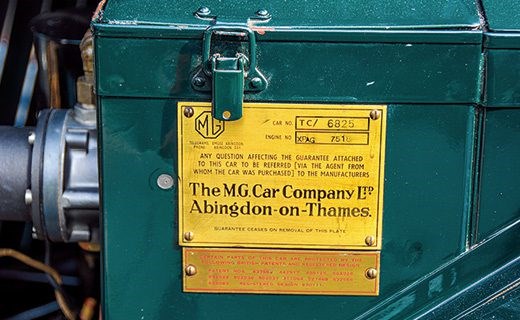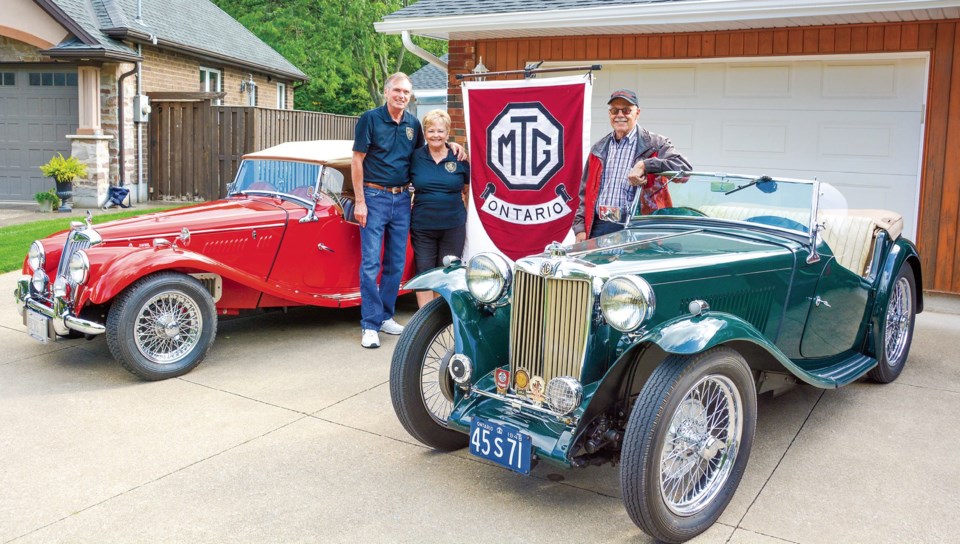Harold and Bev Beamer of Fonthill, and their friend Bob Dobrenski of Vineland, succumbed to the British invasion years ago.
Not the 1960s groups like The Beatles and Herman’s Hermits, but automobiles. Beautiful, handmade convertibles, built in England in the post-war era.
Harold, Bev, and Bob, like thousands of others across North America, are MG fanatics, members of car clubs extolling the virtues of the vintage vehicles. Members of the Ontario chapter meet semi-annually to celebrate with a special driving route and banquet. This year, it will take place the weekend of September 30 through October 2, at the Four Points Sheraton in Thorold.
“We should have celebrated our 50th anniversary of the Ontario chapter of the club in 2019,” said Bev, “but because of COVID, it’s been delayed two years. We meet twice a year, so this is our hundredth gathering of people from all over the province. We also have a local group in Niagara that gets together for a drive and a pub stop.”
Added Bob, “We call it GOOF, for “Gathering of Ontario Faithful.”
The MG marque, with its iconic emblem and distinctive octagonal badge, is named for Morris Garages, and is most associated with a line of British open-top, two-seater sports cars (although MG made hardtop coupes and sedans as well), founded by Cecil Kimber in Oxford, England in the 1920s. As the business expanded, it moved to Abington on Thames, Oxfordshire where it operated for decades, only disrupted by WWII when it retooled to make aircraft assemblies, light tanks, and other weapons.
MG established a name for itself in the early days of international automobile racing. Car production continued after the war, and the company achieved great success exporting vehicles worldwide. In the mid-1970s, MG was absorbed by British Leyland, which also held the Triumph, Austin-Morris, Rover, and Jaguar brands, and switched ownership a couple more times until production was suspended in 2005. In 2007, Chinese ownership took over.
MG car clubs already existed in Britain, and a New England car club was founded in the late 1960s by a couple of MG aficionados who placed an ad in Road and Track magazine to attract other fans of the cars. Soon there were enough members to organize into chapters, with Ontario being the first chapter of the New England club.
“Harold and I joined the Ontario MGT Register in 1977,” said Bev, “although the provincial club started in 1969. We bought our first MG, a 1958 MGA, in 1968 and have been MG owners for 54 years.”

Their red 1954 MG-TF sits in the driveway beside Bob’s green 1948 MG-TC. Bob, who also owns an MGA, joined the car club in 1973. All the cars are kept in pristine condition.
“These cars were all handmade as they went down the assembly line,” said Harold. “The fenders and bodies were not made in-house. If you take all the sheet metal off, the frame is made of wood, white ash. It’s the same technology that went into the Ford Model T and Model A. The English had lots of workers skilled in carpentry, bending wood and shaping wood, and they were employed in the industry.”
Many servicemen brought MG-TCs back to America and Canada after WWII, because they had seen them and driven them in Britain, said Harold.
“They would end up racing their MGs on courses set up at old aerodromes, creating chicanes with hay bales. They would race against old Porsches, Triumphs, and Morgans in a class called “vintage racing,” which still goes on today at tracks like Watkins Glen, NY and Mosport, ON. The MGAs came out around 1955, and they had a full metal, welded, monocoque body. The well-known MGBs came out in 1964.”
MG had a network of mechanical support in North America for those not adept at tinkering with their own engines, said Bob.

“The cars had two carburetors which had to be balanced and set up properly to be reliable, and the electrics on the cars weren’t the best,” he said. “The vintage MGs run best on high-octane, non-ethanol fuel. I’ve got almost 50,000 miles on my MG-TC, and have driven it all the way to Newfoundland, down to Tennessee, and Chicago. I’ve never had trouble with it.”
The reunion weekend will feature visits to Niagara wineries in the MGs. Bob is the route organizer for the 26 cars and 50 participants, many being husband-wife driving teams.
“We’ll gather near Brock, and head west to St. Johns and Effingham, with lunch at Ball’s Falls, then onwards to Cave Springs Winery in Jordan, then to Jackson Flats and Decew Falls, and finally back to the hotel for supper,” said Bob.
Bev is not enamored exclusively of British cars. In her garage sits her 2010 V-8 Mustang GT convertible in a deep red hue, with a rich brown interior ordered specially from the Ford factory. In the bay next to the Mustang sits Harold’s MGB-GT fastback hardtop, in slate grey metallic.
“My Mustang only has 29,000 kilometres on it,” said Bev proudly. “We only drive it in September and October.”



